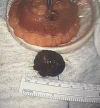Laparoscopic-Assisted Enterolithotomy for Recurrent Gallstone Ileus: A Case Report
- PMID: 39712822
- PMCID: PMC11663021
- DOI: 10.7759/cureus.74123
Laparoscopic-Assisted Enterolithotomy for Recurrent Gallstone Ileus: A Case Report
Abstract
Gallstone ileus is the mechanical obstruction of the bowel due to gallstone impaction. It forms when a fistula is created between the gallbladder and the gastrointestinal tract, which can result in small bowel obstruction. Its surgical management ranges from enterolithotomy, cholecystectomy, and fistula closure performed together (one-stage) or performed separately (two-stage), while some patients undergo simple enterolithotomy. Emergency surgery with open enterolithotomy, with or without biliary tract surgery, has been replaced by laparoscopic-assisted enterolithotomy as a safer and more rapid procedure. This report is of a 68-year-old woman treated with laparoscopic-assisted enterolithotomy for gallstone ileus which recurred. A 68-year-old woman with type 2 diabetes mellitus, hypertension, breast cancer, and end-stage renal disease on hemodialysis presented with a gallstone ileus and was surgically managed with successful laparoscopic-assisted enterolithotomy. Seven days after the initial surgery, she again presented with gallstone ileus requiring reoperation. A repeat laparoscopic-assisted enterolithotomy was performed with no complications and full resolution of her symptoms. Operative management of gallstone ileus and subsequent recurrence continues to be highly debated. With no randomized studies and limited data, there is no current gold standard surgical procedure for either setting. Simple laparoscopic-assisted enterolithotomy is the favored surgical technique as it is associated with decreased morbidity, mortality, operative time, and complications. This report demonstrates that a CT scan is crucial in differentiating recurrent gallstone ileus from postoperative ileus, with a repeat laparoscopic-assisted enterolithotomy providing a safe and effective treatment option. Moreover, patient follow up is essential for monitoring symptom resolution.
Keywords: case report; entero-biliary fistulae; gallstone ileus; gallstones complication; gastrointestinal ileus; gastrointestinal obstruction; laparoscopic-assisted enterolithotomy.
Copyright © 2024, Vallejo et al.
Conflict of interest statement
Human subjects: Consent for treatment and open access publication was obtained or waived by all participants in this study. Conflicts of interest: In compliance with the ICMJE uniform disclosure form, all authors declare the following: Payment/services info: All authors have declared that no financial support was received from any organization for the submitted work. Financial relationships: All authors have declared that they have no financial relationships at present or within the previous three years with any organizations that might have an interest in the submitted work. Other relationships: All authors have declared that there are no other relationships or activities that could appear to have influenced the submitted work.
Figures






Similar articles
-
Gallstone Ileus. What therapeutic options are there?Ann Ital Chir. 2022;92:300-306. Ann Ital Chir. 2022. PMID: 35122424
-
Gallstone ileus- A rare presentation in the era of rampant cholecystectomies.Int J Surg Case Rep. 2024 Jun;119:109702. doi: 10.1016/j.ijscr.2024.109702. Epub 2024 Apr 24. Int J Surg Case Rep. 2024. PMID: 38677255 Free PMC article.
-
Recurrent gallstone ileus.Clin Med Res. 2012 Nov;10(4):236-9. doi: 10.3121/cmr.2012.1079. Epub 2012 Jun 21. Clin Med Res. 2012. PMID: 22723467 Free PMC article.
-
Gallstone ileus, clinical presentation, diagnostic and treatment approach.World J Gastrointest Surg. 2016 Jan 27;8(1):65-76. doi: 10.4240/wjgs.v8.i1.65. World J Gastrointest Surg. 2016. PMID: 26843914 Free PMC article. Review.
-
The Rolling Stones: A Systematic Review and Meta-Analysis of the Management of Gallstone Ileus.Chirurgia (Bucur). 2024 Oct;119(5):483-514. doi: 10.21614/chirurgia.3046. Chirurgia (Bucur). 2024. PMID: 39520187
Cited by
-
A Case of Recurrent Gallstone Ileus Treated with Enterolithotomy Alone.Case Rep Gastroenterol. 2025 Jun 5;19(1):397-402. doi: 10.1159/000545980. eCollection 2025 Jan-Dec. Case Rep Gastroenterol. 2025. PMID: 40476148 Free PMC article.
References
-
- Complications of gallstone disease: Mirizzi syndrome, cholecystocholedochal fistula, and gallstone ileus. Abou-Saif A, Al-Kawas FH. https://pubmed.ncbi.nlm.nih.gov/11866258/ Am J Gastroenterol. 2002;97:249–254. - PubMed
-
- Comparison of surgical treatments of gallstone ileus: preliminary report. Doko M, Zovak M, Kopljar M, Glavan E, Ljubicic N, Hochstädter H. World J Surg. 2003;27:400–404. - PubMed
Publication types
LinkOut - more resources
Full Text Sources
